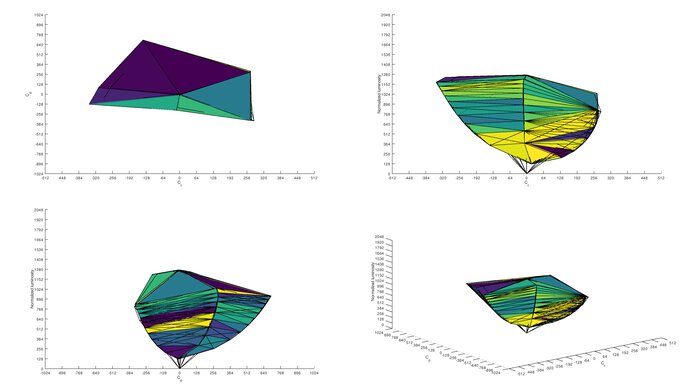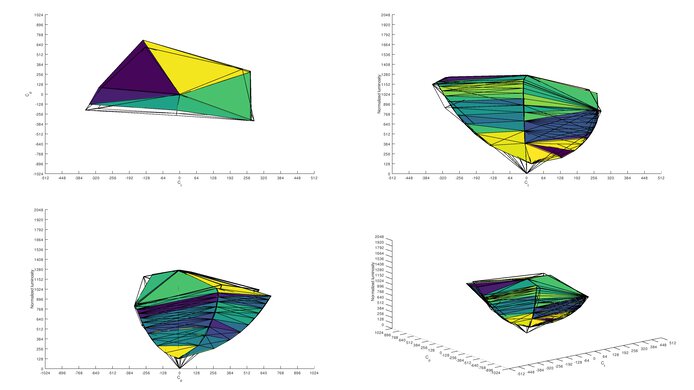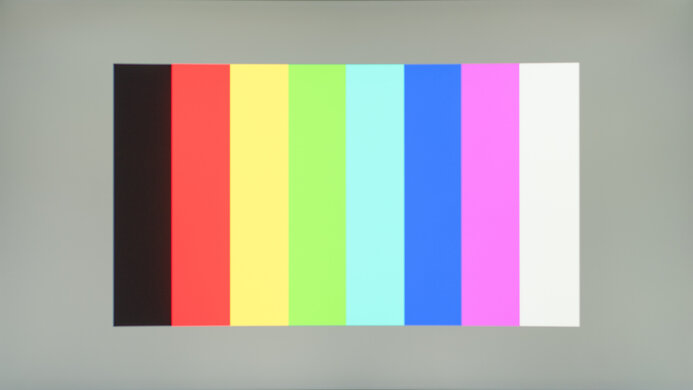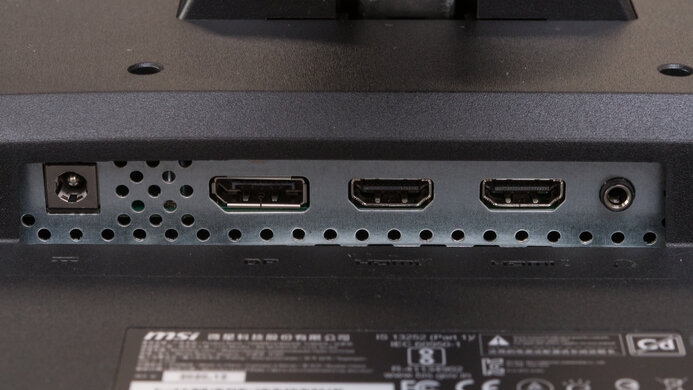The MSI Optix G27CQ4 is a very good budget-friendly gaming monitor with a 27 inch screen and 1440p resolution. It has all the features most gamers are looking for, like FreeSync variable refresh rate (VRR) support and a native 165Hz refresh rate. Its input lag is really low, but even though it has a quick response time, you may notice some motion blur in fast-moving scenes. Its VA panel has a high native contrast ratio, but it lacks a local dimming feature to improve it. The viewing angles are narrow, and the stand doesn't offer many adjustments, so it's hard to place it in an ideal viewing position if you need to share it with someone else. Lastly, it doesn't support HDR, which is somewhat expected for a model in this price range.
Our Verdict
The MSI Optix G27CQ4 is decent for mixed usage. It's very good for gaming because it has a high refresh rate with VRR support. Its low input and quick response time deliver a responsive gaming experience, but some motion blur is visible with fast-moving objects. It's decent for office use thanks to its high peak brightness and good reflection handling, but it has terrible ergonomics and narrow viewing angles, making it harder to share the screen with someone else.
- Gets bright enough to combat glare.
- 165Hz refresh rate and VRR support.
- High native contrast ratio.
- Stand only allows for limited tilt adjustment.
- Some visible motion blur.
- No HDR support.
The MSI Optix G27CQ4 is decent for office use. The high-resolution, 27 inch screen provides clear text and crisp images. It has good reflection handling and gets bright enough to combat glare in well-lit rooms. Sadly, it has narrow viewing angles and terrible ergonomics, so it's not the best choice if you need to share your screen with others.
- Large 27 inch screen and high resolution.
- Gets bright enough to combat glare.
- Narrow viewing angles.
- Stand only allows for limited tilt adjustment.
The MSI Optix G27CQ4 is very good for gaming. It has a high 165Hz refresh rate with native FreeSync support to reduce screen tearing. It has low input lag and a quick response time, but some people may still notice motion blur. It's also great for dark room gaming thanks to its high native contrast ratio, but it lacks a local dimming feature.
- Very low input lag.
- 165Hz refresh rate and VRR support.
- High native contrast ratio.
- Stand only allows for limited tilt adjustment.
- Some visible motion blur.
The MSI Optix G27CQ4 is okay for watching multimedia content. It has a high resolution to deliver crisp images. It performs well both in bright and dark rooms thanks to its high peak brightness and great contrast ratio. However, it has narrow viewing angles, so those viewing from the side see an inaccurate image.
- Large 27 inch screen and high resolution.
- Gets bright enough to combat glare.
- Narrow viewing angles.
- Stand only allows for limited tilt adjustment.
The MSI Optix G27CQ4 is alright for content creators. It has a large screen and high resolution, so there's enough space to work on your video's timeline. It gets bright enough to combat glare and has good reflection handling if you work in a well-lit room. However, its terrible ergonomics and narrow viewing angles make it hard to share the screen with a coworker or client around you.
- Large 27 inch screen and high resolution.
- Gets bright enough to combat glare.
- Narrow viewing angles.
- Stand only allows for limited tilt adjustment.
The MSI Optix G27CQ4 doesn't support HDR.
Check Price
Differences Between Sizes And Variants
We tested the MSI Optix G27CQ4 in a 27 inch size, and it's also available in a 32 inch size, which we expect to perform similarly. There are other monitors in MSI's G Series lineup, which you can see below.
| Model | Size | Type | Resolution | Refresh Rate | Notes |
|---|---|---|---|---|---|
| MSI Optix G27C4 | 27" | VA | 1080p | 165Hz | |
| MSI Optix G27CQ4 | 27" | VA | 1440p | 165Hz | |
| MSI Optix G27CQ4P | 27" | VA | 1440p | 165Hz | Height adjustable stand |
| MSI Optix G32CQ4 | 31.5" | VA | 1440p | 165Hz |
If someone comes across a different type of panel, or if their MSI Optix G27CQ4 doesn't correspond to our review, let us know and we'll update the review. Note that some tests, like the gray uniformity, may vary between individual units.
Our unit was manufactured in December 2020 and you can see the label here.
Popular Monitor Comparisons
The MSI Optix G27CQ4 is a very good budget gaming monitor. It has most features gamers are looking for, like VRR support and a high refresh rate. It also has a great native contrast ratio, but other than that, there's nothing that stands out against its competition. It provides good value for its price, but there are better and cheaper options available, like the Gigabyte G27QC.
Also see our recommendations for the best budget monitors, the best 1440p monitors, and the best gaming monitors.
The BenQ EX2780Q and the MSI Optix G27CQ4 are both very good gaming monitors with different panel types. The BenQ is a 144Hz monitor with an IPS panel with wider viewing angles, and the MSI has a 165Hz refresh rate and a VA panel with higher contrast. The BenQ supports HDR, which the MSI doesn't, and it has quicker response times, so motion looks better.
The MSI Optix G27CQ4 and the Samsung Odyssey G55T C27G55T are both good gaming monitors. They each have a VA panel with a 1440p resolution, and they offer similar features, but the MSI has a 165Hz refresh rate compared to the Samsung's 144Hz. The MSI is also flicker-free at all brightness levels, while the Samsung flickers at lower brightness levels. The Samsung supports HDR, which the MSI doesn't, but it doesn't add much because it can't display a wide color gamut.
The Gigabyte G27QC is much better overall than the MSI Optix G27CQ4, even though they each have a VA panel, 165Hz refresh rate, and 1440p resolution. The Gigabyte has a quicker response time, resulting in smoother motion, and its BFI feature flickers at a wider range. The Gigabyte also supports HDR10 and has a USB hub, which the MSI doesn't.
The MSI Optix G27CQ4 and the MSI Optix G27C4 are both very good gaming monitors. They're built nearly the same, and each has a VA panel with a 165Hz refresh rate. The main difference is that the G27CQ4 has a 1440p resolution, while the G27C4 is limited to 1080p. The G27CQ4 is a better choice for well-lit rooms because it gets much brighter. However, the G27C4 delivers much smoother motion thanks to its quick response time.

We buy and test more than 30 monitors each year, with units that we buy completely on our own, without any cherry-picked units or samples. We put a lot into each unbiased, straight-to-the-point review, and there's a whole process from purchasing to publishing, involving multiple teams and people. We do more than just use the monitor for a week; we use specialized and custom tools to measure various aspects with objective data-based results. We also consider multiple factors before making any recommendations, including the monitor's cost, its performance against the competition, and whether or not it's easy to find.
Test Results

The MSI Optix G27CQ4 looks like the other entry-level MSI monitors that we've tested, like the MSI Optix G27C4. It has an all-plastic construction with a bit of a gamer-friendly tone, but it shouldn't stick out in an office environment.
The back of the MSI Optix G27CQ4 looks exactly like the MSI Optix G27C4. It's all-plastic with a slight gamer-friendly design to it, and there are air vents directly above the hinge for the stand. Sadly, there isn't much for cable management.
The contrast of the MSI Optix G27CQ4 is great, which is expected from a VA panel. It displays deep blacks when viewed in the dark, but there's no local dimming feature to improve it. It's higher than the advertised 3000:1 contrast, but this can vary between units.
This monitor doesn't have a local dimming feature. The video above is provided for reference only.
The MSI Optix G27CQ4 has good SDR peak brightness. It's higher than the advertised 250 nits, and it's very consistent across different content. Surprisingly, it gets brighter with real content than with the test slides, so it easily gets bright enough to combat glare. We tested the peak brightness after calibration in the 'User' Picture Mode.
This monitor doesn't support HDR.
The MSI Optix G27CQ4 has a narrow horizontal viewing angle, which is expected for a VA panel. The image looks inaccurate as soon as you move off-center, so it's not suggested for co-op gaming.
Once again, the vertical viewing angle is poor. The image looks inaccurate if you mount the screen above eye level.
The MSI Optix G27CQ4 has excellent gray uniformity. Although the edges are a bit darker than the rest, there's no dirty screen effect in the center, which is great. Uniformity is even better in near-dark scenes, but some backlight bleed is visible along the bottom edge. Keep in mind that uniformity can vary between units.
The out-of-the-box accuracy is impressive. Both colors and white balance are slightly inaccurate, but it shouldn't be noticeable for most people. The color temperature is a bit warmer than the 6500K target, giving the image a slightly reddish tint, but not by much. However, gamma doesn't follow the target all that well as some dark scenes are too dark, and other scenes are over-brightened. Keep in mind that accuracy may vary between units.
After calibration, accuracy is incredible. Any remaining inaccuracies can't be spotted by the human eye, and color temperature is very close to the target. Gamma is also improved, except some really dark and bright scenes are still over-brightened.
You can download our ICC profile calibration here. This is provided for reference only and shouldn't be used, as the calibration values vary per individual unit, even for the same model, due to manufacturing tolerances.
Even though it's advertised to have 92% coverage of the DCI P3 color space, it doesn't support HDR so we don't test for it.
This monitor doesn't support HDR.
There are no signs of image retention, even after displaying a high-contrast static image. Keep in mind that this can vary between units.
| Overdrive Setting | Response Time Chart | Response Time Tables | Motion Blur Photo |
| Normal | Chart | Table | Photo |
| Fast | Chart | Table | Photo |
| Fastest | Chart | Table | Photo |
The MSI Optix G27CQ4 has a good response time at its max refresh rate of 165Hz. However, the response times in the darker transitions are slow, and there's too much overshoot in the lighter transitions, so you can still notice motion artifacts in most scenes. The recommended overdrive setting is 'Fastest' because it has a quicker total response time than the other settings.
| Overdrive Setting | Response Time Chart | Response Time Tables | Motion Blur Photo |
| Normal | Chart | Table | Photo |
| Fast | Chart | Table | Photo |
| Fastest | Chart | Table | Photo |
The response time at 60Hz is just okay. The recommended overdrive setting is 'Fast' because 'Normal' is too slow, and there's too much overshoot with 'Fastest'. Still, there's way too much overshoot in the lighter transitions, so motion doesn't look all that good. Also, this means that you may have to change the overdrive setting if the frame rate of your game drops.
The MSI Optix G27CQ4 has a Black Frame Insertion feature to try to improve the appearance of motion. It flickers within a narrow range and can't be used with VRR enabled. Keep in mind that the BFI score is based on the flicker range and not the actual performance.
The MSI Optix G27CQ4 has variable refresh rate support in the form of native FreeSync support. It isn't officially listed as G-SYNC compatible by NVIDIA, but it works. You can achieve its full refresh rate range over a DisplayPort connection. Over HDMI, only FreeSync works, and the max refresh rate is 144Hz.
The MSI Optix G27CQ4 has incredibly low input lag that remains low with VRR enabled. It increases slightly with BFI enabled, but most people shouldn't notice it.
The large 27 inch screen has a high 1440p resolution, which helps delivers crisp images. This is an upgrade over the MSI Optix G27C4, which has a 1080p resolution. There's also a 32 inch version, the G32CQ4, which has the same resolution, resulting in a lower pixel density.
Like some other MSI monitors we've tested, this one doesn't have any USB inputs.
The MSI Optix G27CQ4 is limited on extra features, but it has:
- Crosshair: Adds a virtual crosshair on the screen for FPS games.
- Low Blue Light Mode: Removes blue light to help reduce eye strain.
- Frame Rate Counter: Displays the current frame rate of your game.















































